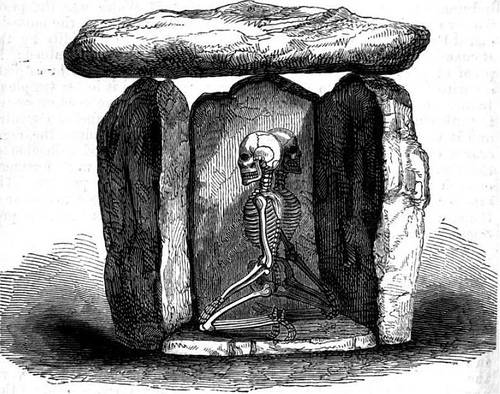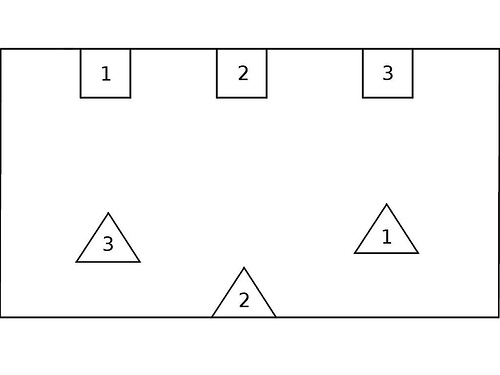Margaret Mitchell composed Gone With the Wind while nursing a broken ankle.
She wrote the last chapter first and the first chapter last.
Margaret Mitchell composed Gone With the Wind while nursing a broken ankle.
She wrote the last chapter first and the first chapter last.

The above sketch represents a chamber which was discovered in a barrow, situated near Paradis, in the parish of the Vale, in the island of Guernsey. On digging into the mound, a large flat stone was soon discovered; this formed the top, or cap-stone, of the tomb, and on removing it, the upper part of two human skulls were exposed to view. One was facing the north, the other the south, but both disposed in a line from east to west. The chamber was filled up with earth mixed with limpet-shells, and as it was gradually removed, while the examination was proceeding downwards into the interior, the bones of the extremities became exposed to view, and were seen to greater advantage. They were less decomposed than those of the upper part; and the teeth and jaws, which were well preserved, denoted that they were the skeletons of adults, and not of old men. The reason why the skeletons were found in this extraordinary position it is impossible to determine. Probably the persons who were thus interred were prisoners, slaves, or other subordinates, who were slain — perhaps buried alive — on occasion of the funeral of some great or renowned personage, who was placed in the larger chamber at the end of the passage; and this view of the case is considerably strengthened by the fact that the total absence of arms, weapons, or vases, in the smaller chamber, denotes that the quality of the persons within it was of less dignity or estimation.
— Edmund Fillingham King, Ten Thousand Wonderful Things, 1860

The last golf shots on the moon were taken by Apollo 14 astronaut Alan Shepard in February 1971.
When the crew returned to Earth, they received the following telegram from the Royal and Ancient Golf Club in Scotland:
Warmest congratulations to all of you on your great achievement and safe return. Please refer to the Rules of Golf section on etiquette, paragraph 6, quote – before leaving a bunker a player should carefully fill up all holes made by him therein, unquote.
Forget everything you know about reducing fractions — it turns out you can just cancel individual digits:

Not convinced?


This would have made fifth grade so much easier …
(This is a ***JOKE*** -- please don't take it seriously.)
A panic terror of the end of the world seized the good people of Leeds and its neighborhood in the year 1806. It arose from the following circumstances. A hen, in a village close by, laid eggs, on which were inscribed the words, “Christ is coming.” Great numbers visited the spot, and examined these wondrous eggs, convinced that the day of judgment was near at hand. Like sailors in a storm, expecting every instant to go to the bottom, the believers suddenly became religious, prayed violently, and flattered themselves that they repented them of their evil courses. But a plain tale soon put them down, and quenched their religion entirely. Some gentlemen, hearing of the matter, went one fine morning and caught the poor hen in the act of laying one of her miraculous eggs. They soon ascertained beyond doubt that the egg had been inscribed with some corrosive ink, and cruelly forced up again into the bird’s body. At this explanation, those who had prayed, now laughed, and the world wagged as merrily as of yore.
— Edmund Fillingham King, Ten Thousand Wonderful Things, 1860
“Study without desire spoils the memory, and it retains nothing that it takes in.” — Leonardo da Vinci
Here lies a man that was Knott born,
His father was Knott before him,
He lived Knott, and did Knott die,
Yet underneath this stone doth lie.
— Epitaph of John Knott, Sheffield, England

Here’s a simplified version of a classic puzzle by Sam Loyd. Connect each square to its triangle with a line. The lines must stay within the boundary and may not cross one another.
There’s something unusual about the Ulas family of southern Turkey — five of its 19 adult children have never walked upright. Instead they move in a “bear crawl,” using their feet and the palms of their hands. This is not knuckle-walking, as apes do. The five share a congenital brain impairment that prevented them from learning to crawl normally as infants, and apparently they developed the bear crawl to compensate.
The five affected children are 18-36 years old now and the subject of intense study by neurologists, evolutionary theorists, anthropologists, and geneticists, as such a gait has never been reported before. The cause of their disorder remains a mystery.
London dentist Martin van Butchell always read the fine print. So when his wife Mary died in January 1775, he noted that their marriage certificate promised him income so long as Mary was “above ground.”
He enlisted a pair of local doctors to preserve her corpse, replaced her eyes with glass ones, dressed her in a lace gown, and put her on display in his window.
Eventually Butchell remarried, and his new wife objected to the display, so Mary was retired to the Royal College of Surgeons, where she slowly decomposed. In 1941, she was destroyed in a German bombing raid, faithful to the last.